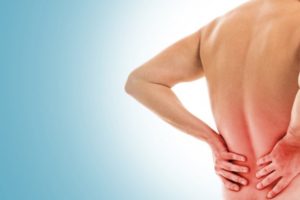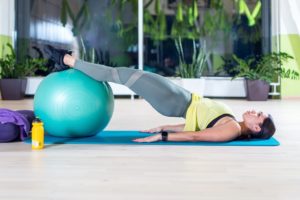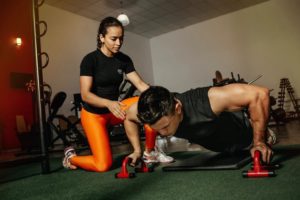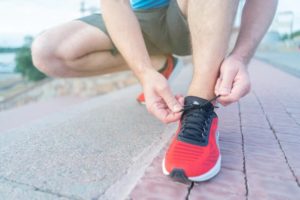It’s estimated that 50% to 80% of people experience at least one episode of back pain during a lifetime. [1],[2]
If you’re on the same boat, You might have also experienced other problems that you have never related to the disc in your back…
for example,
- feeling blue,
- anxious,
- less confident,
- demotivated,
- irritable and
- insecure…
Do you think these have nothing to do with your herniated disc?
And it cannot be solved by herniated disc treatment London?
Believe it or not:
Your bulged herniated disc can be behind your back pain problems!
A herniated disc in your back not only does give you backache and sciatica pain, but also affects your mind.
Even if you keep convincing yourself that you have it all under control.
Learn how Hayley, Jan, Dr Christian, Michaela, Elizabeth Tiffany , Franco and M Taylor successfully rehabbed their back injuries and beat their back pain.
Read on to find out how this happens, how online herniated disc rehabilitation helps you restore your positive mindset.
And also learn which exercises to do and which herniated disc exercises to avoid in order to prevent further injury.

How Physical Injury Affects your Mind
You might be looking for the best herniated disc treatment London.
You might have also considered the right herniated disc exercises to avoid worsening your physical symptoms.
But you never considered dealing with the mental drawbacks of injury!
As a matter of fact, Injury affects you not only physically, but also mentally as it is always accompanied by:
- Pain
You might think of pain as a physical sensation.
But it is more than that.
It affects your emotions and psychology. [1]
Although pain is one important sign that tells you it’s time to seek herniated disc treatment London, experiencing pain can trigger emotional reactions that include:
- Anxiety,
- Fear,
- Less confidence,
- Anger,
- Guilt,
- Pain catastrophising
- Frustration, and
- [1], [3]
These emotional reactions affect your quality of life, and automatically make you perceive pain as more intense, even though your pain might haven’t changed.
Expert tip: It is true that injury from physical activities might have been the cause of your pain. But those were the wrong activities!
The right ones, on the other hand, can take your pain away, only if you learn the right exercises to do and the herniated disc exercises to avoid.

- Limitation in Physical Activity
When you’ve a physical problem in general – back pain and sciatica in particular – your daily life activities become limited.
In other words, simple things that you used to do in the past like just bending down, carrying shopping bags, coming out and getting into a car or taking the laundry out of the basket, may now seem hard, or even impossible.
As a result, no matter how serious your injury is, it still reflects on your emotions by giving you the feeling of:
- Depression
- Anxiety
- Upset and frustration
- Fatigue
- Mood swings
- Appetite changes and
- Sleep troubles
- Dependence
- Low self-esteem [7],[8],[9]
These factors – and more – are the main reason why your life has completely changed after suffering from a herniated disc and low back pain.
It gradually affects how you spend your days,
and affects your relationship with your family and friends
and also, completely changes the way you see yourself.
If you are looking for an expert personal trainer who would consider your physical and emotional problems while planning your rehabilitation programme, Jazz Alessi is here for you.
REQUEST A FREE CONSULTATION NOW!Because you deserve a life of the best quality, here’s how an evidence based herniated disc rehabilitation can help you not only cope with these emotional problems, but also beat them!
And all from the comfort of your home!

One-to-one online Rehabilitation: Changes your mind, body and life
Although psychological problems associated with back pain are usually overlooked by most personal trainers, Jazz Alessi believes rehabilitation must be assessment-based (evidence-based), comprehensive and must also cover the emotional and psychological aspects.
Here are 8 benefits by which customised online rehabilitation can contribute to better mental health:
- Increased self-confidence
When you have a back problem, your confidence is majorly compromised.
You basically think twice before doing anything, because you are not sure if you will be able to do it.
Back pain affects your relationships, activities, all exercise choices and makes you think twice before getting out of bed in the morning.
Back pain rehab, on the other hand, helps you restore your lost abilities, confidence, strength recognise your maximum potentials and take challenges in a customised manner with the help of a professional trainer on 1-2-1 basis.
Simply, when you exercise, you feel better about yourself, look better and become capable of carrying out your daily tasks with no difficulty, this boosts your mood and makes you more satisfied about who you are.
This is always reflected on your relationship with your partner, friends, colleagues and family.
- Independence
Being able to carry things into and out of the car, lifting your kids or just go shopping instead of ordering groceries are big achievements to celebrate when you have back pain due to a herniated disc.
The feeling of being independent, being able to accomplish your tasks, and being not in need for help are important things which proper rehabilitation can give you when it is specifically tailored to meet your needs.
Never under-estimate independence!
Feeling independent puts you in a massive good mood, improves your brain health, self-confidence and makes you able – and willing – to socialise with your loved one, go out with friends and get the job you deserve without feeling afraid of excruciating back pain.

- Better sleep
You can say goodbye to all your sleep troubles by simply starting to exercise regularly.[7]
based on evidence, it was found that customised to your needs moderate and intense exercise 2-3 times a week can:
– Improve sleep pattern
– Reduce sleep onset (the time you take in bed before you fall asleep)
– Improve sleep quality
Reduce daytime sleepiness
– Decrease incidence of sleep disorders, sleep apnoea, insomnia and restless leg syndrome [13], [14]
In addition to the good mood that “one night of good sleep” can put you in, having good sleep at night turns you to a super-achiever.
Good sleep helps you concentrate, boosts your memory and improves your brain health.
It also gives you proper energy during the day and reduces irritability and intolerance.
Which means a whole-new, better version of you!
4. Better appetite for healthy options whilst reduce cravings
Doing the right exercises recommended by your expert personal trainer can play an important role in regulating and controlling your appetite. [10]

Whether you eat more than you should, or you eat less than your body needs, exercises can help you get in moderation.
Exercise does so by:
- boosting resting metabolic rate.
- stomach adjustment to ingested food.
- regulating the secretions of hormones
- regulating your sense of hunger. [4,5]
Because every one has a different body, with different nutritional needs.
It is difficult to find a one-diet-fits-all that can make everyone achieve their health goals.
For this reason, only customised nutrition plan can help you control your cravings, make wiser food choice and quit poor eating by correctly regulating your hormones like ghrelin, insulin and leptin.
Exercising also helps you convert the food you eat into energy and minimises fat storage in your body. [4,5]
Taking care of what you eat while recovering from a herniated disc is vital.
But if you don’t know what to eat, and you are looking for professional help; Jazz Alessi can give you the best customised food choices that can help you recover fast.
REQUEST A CONSULTATION FOR FREE!- Less Stress and Anxiety
Looking for a gentle, yet beneficial exercise to sweat away your stress?
Pilates can be what you are looking for.
With the right Pilates training, you can decrease the pain in your back.
Based on several studies, it is evident that Pilates can cause long-term reduction in low back pain.
This is because Pilates training helps you:
- improve your flexibility
- enhance control-mobility of your torso and pelvic segments.
- prevent musculoskeletal injury
- Improve your balance and coordination
- Improve your core stability
- Boost your mood and reduce your pain [6]
in addition to Pilates, other exercises like yoga can also miraculously decrease your stress and anxiety by different mechanisms. [7,9,10]
Based on research, exercising increases substances called endocannabinoids which are natural pain killers. [9]
These substances also promote a sense of well-being and satisfaction [9]
It also decreases cortisol production, known as stress hormone, improves mood, and quality of life [9,11]
Expert tip: Everyone is different, not all yoga positions and Pilates exercises are suitable for your slipped disc.
Make sure your exercise plan is personally tailored for your condition to avoid re-injury.
If you want to find out which Pilates and Yoga poses to avoid and which exercises to include in your rehabilitation routine, you need a personal trainer who will perform a comprehensive assessment and pay attention to your very small details.
Just like Jazz Alessi!
REQUEST A FREE CONSULTATION NOW!- Better self-image
Building a healthy sense of self is one important step towards a better personality and a healthier mind.
When you exercise based on a laser-sharp personalised programme, the way you think of yourself changes, you start seeing yourself as a capable, powerful person.
And you start realising – and appreciating – your potentials. [11]
additionally, the better self-image you develop also includes your physical appearance.
you start seeing yourself as a healthy, active person with an agile and strong, erect posture and flexible body.
These changes in your self-image highlights your strengths and dampens your weaknesses.
It also improves your mood, motivates you to try and accomplish new things and gives you a push forward to achieve more goals.

- Eliminate Your Anxiety and Depression
Based on a recent study, more than 340 million people are affected by depression all over the world.[9]
Including those who are depressed due to health conditions.
And disc herniation is not an exception.
Good news is: It is scientifically evident that taking part in a back rehabilitation programme is effective in helping to get rid of your anxiety and depression [7]
in all depressed patients, brain volume was decreased based on radiological images.
When examined after prescribing anti-depressant drugs, brain volume was increased. [9,10]
Surprisingly, exercising can have a similar effect on your brain!
When the right exercise plan is designed to match your very unique case, you can promote neurogenesis and helps reverse what depression might have done to your brain. [9]
8. Motivation And Sense Of Accomplishment
Everyone likes to see their own achievements before their eyes.
This unique sense of accomplishment can:
- have a positive influence on your self-perception,
- improve your body image and
- improve your self-worth.
- lead to active feelings of self-efficacy and self-esteem [7]
- having a better, dream relationship with your better half
- become promoted into a better job and getting paid more
This change in your mindset will keep you motivated to accomplish more, and will help you keep up with the rehab programme until full recovery.
Need to get a laser-sharp personalised rehab plan for your herniated disc?
Want to be supervised by a professional from the comfort of your home?
Speak to Jazz Alessi about your condition and get one-to-one herniated disc online rehab.
REQUEST A FREE CONSULTATION NOW!
Customised Disc Herniation Rehab: Does It Take Forever?
Thinking of your back problem, and hearing the word personalised training makes you think that your rehabilitation programme will take too long.
However, it is completely the other way round.
When your exercise programme is tailored for you, it targets your very personal health problems and achieves faster result.
Jazz Alessi, expert back pain rehabilitation specialist, provides a safe and customised and comprehensive rehabilitation programme that you can follow online, and from the comfort of your home.
He safely divides disc herniation programme to 3 phases, after which at least 70 – 98% of your goals will be already achieved.
Typically, here is what to expect:
1st Phase – STABILISE
This is not a pre-determined programme you will find over the internet.
This is laser-sharp customised programme providing you with evidence-based, fast and effective changes on the spot as you exercise, and it is carried out throughout your programme.
After getting your proper diagnosis, medical herniated disk treatment, and you are referred for rehabilitation,
and depending on the onset of your pain, severity of your symptoms and personal goals, the first phase of rehab will focus on a large number of things and here are just a few of these:
- Reducing your pain by 50 – 85% so that you can move forward and faster in your rehabilitation plan.
This is done by conducting a professional and comprehensive assessment to determine the course, nature and severity of your pain – you will need to share all your medical history, diagnosis and the herniated disk treatment prescribed by your clinician.
- Restoring your joint range of movement
- Controlling muscle spasm and restoring flexibility
- Gradually increasing power of muscles
- Restoring movements that you could not do before and improve your level of function
- Eliminate as many limitations as possible
Your body, muscles, joints and body segments require a precise advanced assessment and a specific amount of laser sharp customised training.
To achieve the best benefits of this phase, you will need 3-4 customised sessions/week and Phase 1 will last for 4-6 weeks.

2nd Phase – CONSOLIDATE
Based on your Phase (1) programme, your rehab will continue introducing you to the next level of herniated disc exercise customisation.
As this phase begins, you probably will have completed your medical herniated disk treatment and will rely completely on rehab. (don’t forget to ask your physician before stopping your medical treatment for herniated discs).
In this phase, you will continue noticing the dramatic 70-90% decrease in your pain with restoration of many normal functions to near-normal levels.
At the end of this phase, you will also be professionally prepared to exercise on your own safely.
By the end of this phase, the risk of re-injury will significantly decrease.
This phase will usually take in between 12-16 more sessions.
Because you have less pain and you are perfectly retrained, you will become more versatile with your moves and exercises, achieve superior strength, flexibility, and body coordination, become a lot more certain in everything you do.
This gives you an extraordinarily strong positive outlook, good mood and you will certainly make you a lot happier and hugely more confident.
In case of a flare up / crisis, you will know exactly what to do on your own before seeking medical treatment for herniated discs, this expert knowledge alone provides you with massive benefits.
At the end of Phase 2 Disc Herniation Rehab, you know with certainty that you are winning!
Amongst other things at the end of this phase, your strength will increase significantly.
Your muscles, joints flexibility, mobility and range of movement will progress to a superior level (all safe!!).
- You will also feel very positive and be a lot happier.
- At the end of this phase, you have rebuilt your body functionality near your maximum (whatever this maximum might be for you).
- Subject to your load / movement assessment at the end of this phase you would have gained all this life-lasting knowledge personalised to your injury.
3rd Phase – PROGRESS (better than before!)
At the end of this phase, as you move from the second phase, you can perform everything (or most of the exercises and movements) and make long-lasting progress.
At the end of Phase 3 of Disc Herniation Rehab, you would have re-built your spine strength, functionality, awareness, and back balance to the ultimate level.
Many parts of your spine and body are better trained and prepared compared with before the injury occurred.
Therefore, you are a lot stronger and the risk of re-injury is low.
This phase is also fully customised as it is quite different from person to person.
A significant number of clients only require phase 1 (stabilise) and phase 2 (consolidate) as their disc herniation rehab programme along with some temporary medical treatment for herniated discs at the acute stage of their injuries.
- Keen to leave current limitations, anxiety and depression behind and get started?
- Apply now for your FREE CONSULTATION!
References
1-American Psychological Association, www.apa.org/helpcenter/pain-management.aspx
- Eccleston, The role of psychology in pain management, British Journal of Anaesthesia, Vol 87,
Issue 1, 2001, http://bja.oxfordjournals.org/content/87/1/144.full
2-Rubin DI. Epidemiology and risk factors for spine pain. Neurol Clin. 2007 May;25(2):353-71. doi: 10.1016/j.ncl.2007.01.004. PMID: 17445733.
https://pubmed.ncbi.nlm.nih.gov/17445733/
3-Penlington, Chris & Urbanek, Monika & Barker, Sarah. (2019). Psychological Theories of Pain. Primary dental journal. 7. 24-29. 10.1177/205016841800700407.
https://www.researchgate.net/publication/331556529_Psychological_Theories_of_Pain
4- Bilski, Jan & Teległów, Aneta & Zahradnik-Bilska, Janina & Dembiński, Artur & Warzecha, Zygmunt. (2009). Effects of Exercise on Appetite and Food Intake Regulation. Medicina Sportiva. 13. 82-94. 10.2478/v10036-009-0014-5. https://www.researchgate.net/publication/216042358_Effects_of_Exercise_on_Appetite_and_Food_Intake_Regulation
5- Martins, Catia & Morgan, Linda & Truby, H.. (2008). A review of the effects of exercise on appetite regulation: An obesity perspective. International journal of obesity (2005). 32. 1337-47. 10.1038/ijo.2008.98.
https://www.researchgate.net/publication/5244299_A_review_of_the_effects_of_exercise_on_appetite_regulation_An_obesity_perspective
6- Phrompaet S, Paungmali A, Pirunsan U, Sitilertpisan P. Effects of pilates training on lumbo-pelvic stability and flexibility. Asian J Sports Med. 2011 Mar;2(1):16-22. doi: 10.5812/asjsm.34822. PMID: 22375213; PMCID: PMC3289190.
https://pubmed.ncbi.nlm.nih.gov/22375213/
7- Lauren Muhlheim : Why Exercise? The Psychological Benefits of Physical Activity
https://www.eatingdisordertherapyla.com/wp-content/uploads/2015/06/Why-Exercise.pdf
8- Gogulla S, Lemke N, Hauer K. Effekte körperlicher Aktivität und körperlichen Trainings auf den psychischen Status bei älteren Menschen mit und ohne kognitive Schädigung [Effects of physical activity and physical training on the psychological status of older persons with and without cognitive impairment]. Z Gerontol Geriatr. 2012 Jun;45(4):279-89. German. doi: 10.1007/s00391-012-0347-x. PMID: 22622676.
https://pubmed.ncbi.nlm.nih.gov/22622676/
9-Carek PJ, Laibstain SE, Carek SM. Exercise for the treatment of depression and anxiety. Int J Psychiatry Med. 2011;41(1):15-28. doi: 10.2190/PM.41.1.c. PMID: 21495519.
https://www.exerciseismedicine.org/singapore/assets/page_documents/Exercise_N_Depression.pdf
10- Kregel J, Meeus M, Malfliet A, Dolphens M, Danneels L, Nijs J, Cagnie B. Structural and functional brain abnormalities in chronic low back pain: A systematic review. Semin Arthritis Rheum. 2015 Oct;45(2):229-37. doi: 10.1016/j.semarthrit.2015.05.002. Epub 2015 May 16. PMID: 26092329.
https://pubmed.ncbi.nlm.nih.gov/26092329/
11- Dolenc, Petra & Petrič, Mojca. (2019). PSYCHOLOGICAL BENEFITS OF EXERCISE AND PHYSICAL ACTIVITY IN OLDER ADULTS. Annales Kinesiologiae. 9. 121-134. 10.35469/ak.2018.167.
https://www.researchgate.net/publication/334067449_PSYCHOLOGICAL_BENEFITS_OF_EXERCISE_AND_PHYSICAL_ACTIVITY_IN_OLDER_ADULTS
12- Blundell, J.E., Gibbons, C., Caudwell, P., Finlayson, G. and Hopkins, M. (2015), Appetite control and exercise. Obes Rev, 16: 67-76. https://doi.org/10.1111/obr.12257
https://onlinelibrary.wiley.com/doi/full/10.1111/obr.12257
13- Kline CE. The bidirectional relationship between exercise and sleep: Implications for exercise adherence and sleep improvement. American Journal of Lifestyle Medicine. 2014 Nov-Dec;8(6):375-379. DOI: 10.1177/1559827614544437.
http://europepmc.org/article/PMC/4341978
14- Shams, Amir & akbari kamrani, Ahmadali & Shamsipour Dehkordi, Parveneh & Mohajeri, Robabeh. (2013). Moderate-intensity aerobic exercise improves sleep quality in men older adults. Medicinski glasnik Specijalna bolnica za bolesti stitaste zlezde i bolesti metabolizma Zlatibor. 18. 9-17. 10.5937/medgla1350009S.
https://www.researchgate.net/publication/274147804_Moderate-intensity_aerobic_exercise_improves_sleep_quality_in_men_older_adults
15- Yamato, Tiê & Maher, Chris & Saragiotto, Bruno & Hancock, Mark & Ostelo, Raymond & N, Cabral & Menezes Costa, Luciola & Costa, Leonardo. (2015). Pilates for Low Back Pain. Cochrane database of systematic reviews (Online). 7. 10.1002/14651858.CD010265.pub2.
https://www.researchgate.net/publication/279534204_Pilates_for_Low_Back_Pain



